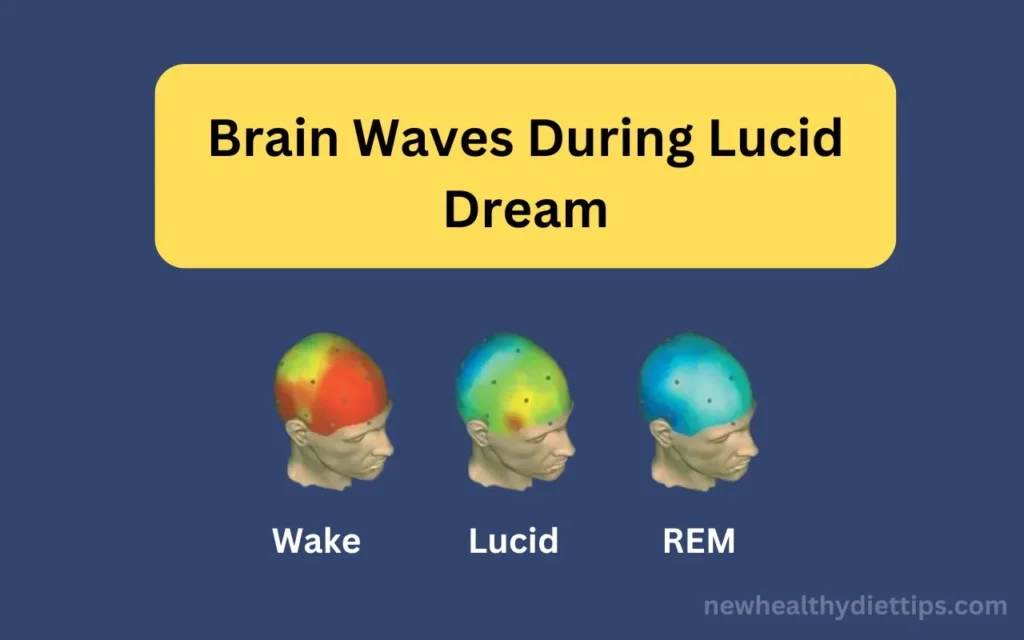You know those fantastic lucid dreams where you realize you’re dreaming and can control it? What’s going on in your brain during magic moments? Lucid dreaming produces intriguing brain wave patterns. Brain waves can indicate whether you’re awake or asleep. Therefore, scientists investigate them during lucid dreams to understand this strange state. This post examines the evidence that brain waves during lucid dream based hybrid states of consciousness. Expect to nerd out on the physics underlying those stunning dreams you can control.
What Happens To Brain Waves During Lucid Dream?
Increased Brain Activity
Your brain activates when you realize you’re dreaming (lucid dreaming). Imagine your typical dreams as a muddy pond with few ripples. Lucid dreams are like throwing a huge boulder into the pond—the splash causes enormous brain activity.
Studies demonstrate that the prefrontal cortex, which controls higher-order thinking, self-awareness, and consciousness, activates during lucid dreams. This region lights up the dreaming mind like a dazzling light.
Cross-Communication Between Brain Regions
When it comes to brain waves during lucid dream, The prefrontal cortex is not the only buzzer. Lucid dreaming appears to open communication between brain areas that are usually separated. The visual, motor and other sensory processing regions begin to communicate with the prefrontal cortex.
Imagine orchestra parts finally coordinating and performing in perfect harmony. This cerebral symphony lets you modify scenarios, summon characters, and fly in your dreams.
Similarities to Waking Consciousness
According to research of brain waves during lucid dream, lucid dreamers and awakened persons share unique brain patterns. Lucid dreaming’s beta wave activity matches attentive, concentrated waking life.
The lucid dreaming brain vacillates between sleep and wakefulness. You’re asleep and dreaming, but your brain acts like you’re awake.
REM Sleep Spikes
Naturally, this increased brain activity and cross-communication occurs during REM sleep, when vivid dreams occur. Lucid dreams cluster during protracted REM, with eye movements, quicker breathing, and enhanced brain oxygenation.
While some areas of your brain may be semi-awakened during a lucid dream, others are still asleep, following REM biological patterns. Our brains strike a careful equilibrium.
In this moment, you are whole, you are enough, and you are loved. 💫 Embrace the stillness within and let it guide you towards a deeper sense of peace and harmony. 🌸 pic.twitter.com/zIWJnfQzRM
— newhealthydiettips (@newhealthy96941) February 7, 2024
What Type of Person Has Lucid Dreams?
You want to know who experiences brain waves during lucid dream and where you’re aware of them. Almost everyone can have lucid dreams. However, some qualities and habits may increase your risk.
Ability to recall dreams
Your vivid dream memory is essential. People who keep a dream journal or reflect on their dreams in the morning experience more lucid dreams. The more you focus on your dreams, the easier it is to recognize them.
Meditation, mindfulness
Meditation and mindfulness increase lucid dreaming. These techniques train your mind to be mindful. Self-awareness helps you recognize dreams.
Creative Personality Types
Creative people like writers, painters, and musicians report more lucid dreams. Brain waves during lucid dream may result from their imagination and willingness to explore other dimensions of consciousness. Thus, right-brain, creative people may have an advantage.
Vivid Dreamers
Many vivid, strange, or unforgettable dreamers also report lucid dreams. Their fantasies are so vivid that acknowledging they are dreams is easier.
Motivation & Methods
With motivation and strategies like reality checks or waking up to bed, most people can learn to have lucid dreams more often. It’s a practiceable skill. While some personality types may be predisposed, anyone can achieve this intriguing state of mind with perseverance.
Are There Any Dangers To Lucid Dreaming?
Disruptive sleep
Brain waves during lucid dream may impair sleep. When you realize you’re dreaming, excitement and stimulus can wake you. This can inhibit deep, peaceful sleep, essential for physical and mental health.
Nighttime wakings might leave you tired and inattentive the next day. So keep lucid dreaming if it affects your sleep.
Dream Anxiety
Realizing they’re dreaming can cause worry or terror for some. If unprepared, losing dreamscape control might be unpleasant. This “dream anxiety” may cause you to wake up stressed or upset.
It takes discipline to stay calm and centred when lucid. Start with simple reality checks to gain confidence before trying more advanced dream control methods.
Possible Addiction
Lucid dreams, like any pleasure, can lead to addiction. Sleeping too much and having lucid fantasies can harm your relationships and work.
Moderation matters when you have brain waves during lucid dream issues. Lucid dreams should be occasional treats, not a daily obsession. Set realistic bounds, and don’t disregard other crucial life components.
Confusing Reality
Most people can distinguish lucid dreams from reality. Few people have confused the two phases following a vivid lucid dream.
If you have a mental health issue, consult a professional before trying lucid dreaming. For safety, avoid the exercise if you have illusions.
Despite being safe for healthy people, lucid dreaming is a powerful experience that can be dangerous if done improperly. Everything should be done moderately and self-awarely to avoid problems.
Conclusion
Brain waves during lucid dream are a beautiful way to control your dreams. According to research, lucid dreams cause brain waves to switch between waking and REM sleep. Understand Brain Waves Chart in 5 Minutes here . Logical thought emerges from dream imagery, activating your prefrontal cortex. Now that you know how lucid dreams happen in your brain, you can try numerous methods to induce them. Maintain reality checks and dream journals. You’ll soon be floating in your own magnificent lucid dream world with hard work. Our Services include the best healthy eating habits, nutrition guides, diet, nutrition plans and newsdailytime.
Activate Your Genius Wave With NASA Researched Based The Genius Wave (90 Days Money Back Guaranteed).
FAQs
What brainwaves trigger lucid dreams?
Results indicate lucid dreaming exhibits REM-like power in δ and θ and higher-than-REM activity in γ, with a peak difference of about 40 Hz.
Which wave promotes lucid dreaming?
Theta and Delta, the slowest brain wave phases, are most common during sleep. Lucid dreaming is better in the 4HZ-8HZ Theta brainwave state.
How uncommon is lucid dreaming?
According to some research, many people have brief lucid dreams. The frequency of lucid dreams in the population varies between 26% and 82%, probably due to methodological discrepancies.
What causes lucid dreams?
These vivid dreams are common during rapid eye movement (REM) sleep, deep sleep with eye movements, faster breathing, and brain activity. REM brain activity is almost identical to awake brain activity.
Can I stay in a lucid dream?
Lucid dreams cannot trap you. Long-term sleep is biologically impossible. No matter what, you’ll wake up after sleep. Lucid dreams give you more control.
Which lucid dreaming level is the highest?
The highest levels of lucidity make you 100% lucid and more comfortable in dreams. Raising awareness to the max. Your ability to affect events may vary.
Can I lucid dream daily?
Research reveals that the typical person has lucid dreams once or twice a month, while some have them more often and some never do in terms of Brain Waves During Lucid Dream.

